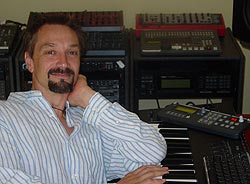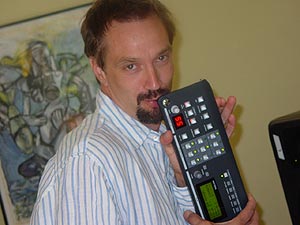Raves on 5.1 and the DS-M7.1 Digital Surround Controller
Profile By Rich Tozzoli
"I'm a home studio that has to compete with post production facilities here in town," states Thousand Oaks, CA based composer/sound designer Chuck Barth. When your working on DVD projects such as Beauty and the Beast, Monsters Inc., Hercules and Corky Romano, your gear better be able to handle anything. In Barth's case, that means surround sound, and lots of it.
"The project I'm working on now is a major Disney title that will be out in the spring and involves over 250 scenes," continues Barth. "Almost 60 of these scenes will be in 5.1 surround, all presented on the same tape and delivery timeline." With pressures like that, what piece of gear handles Barth's critical surround monitoring? The Tascam DS-M7.1 Digital Surround Monitoring Controller.  "Up until having the DS-M7.1, I would have to rent a surround monitoring unit every time I needed it," he noted. "Then I would have to hook up all the cables, speakers and all else that goes with it. What the Tascam offered me was an extremely cost effective solution that was an easy interface with my studio. I don't even think about it now, it's just there and everything is so much easier."
"Up until having the DS-M7.1, I would have to rent a surround monitoring unit every time I needed it," he noted. "Then I would have to hook up all the cables, speakers and all else that goes with it. What the Tascam offered me was an extremely cost effective solution that was an easy interface with my studio. I don't even think about it now, it's just there and everything is so much easier."
Barth was also very careful in researching his purchase of the DS-M7.1. "I had the opportunity to get a number of other surround systems that were extremely expensive, but this one just made the most sense to me. It has so many features on it that I need."
The DS-M7.1 certainly is loaded with essential features for surround production. Standard on the unit are such necessities as Surround Bass Management, Volume control, 44.1, 48, 88.2 and 96kHz operation, 8 input and output channels, a built in Pink Noise generator for monitor calibration and individual channel Mute/Solo and Delay Compensation. As for connections, it has 8-channel TDIF, AES/EBU and ADAT I/O's for a stem recorder. There's a standard TDIF connector for the console, and an AES/EBU and ADAT option available on cards that easily slide into the unit. There's even an AES/EBU insert for surround encoder monitoring. The DS-M7.1 also supports surround formats from LCRS up to 7.1, including 5.1 and 6.1, with the ability to folddown mixes to LR (Left/Right) from any surround format.
"I worked with another production facility that installed the DS-M7.1 and that engineer was really excited about how easy it was to work with," continued Barth. "We did a lot of checking of our folddown mixes at the push of a button. It kept us from needing to have a decoder involved in the chain. Now at my studio, I can quickly check my mixes for downmix compatibility, which is just a huge feature."  As a composer and sound designer, Barth primarily works for Disney in DVD production. His diverse responsibilities include original scores for bonus material, music editing for menus, foley and f/x sound design and even remixing other composers work into 5.1 surround. Barth also creates music and fx for games, composing in such different styles as Big Band, African, and Hawaiian. He uses Tascam's GigaStudio as his main composition tool, in addition to various different synths. "I often work under duress, and sometimes they would like things delivered in a week or less," he noted.
As a composer and sound designer, Barth primarily works for Disney in DVD production. His diverse responsibilities include original scores for bonus material, music editing for menus, foley and f/x sound design and even remixing other composers work into 5.1 surround. Barth also creates music and fx for games, composing in such different styles as Big Band, African, and Hawaiian. He uses Tascam's GigaStudio as his main composition tool, in addition to various different synths. "I often work under duress, and sometimes they would like things delivered in a week or less," he noted.
"My niche is this DVD bonus material," continued Barth. "It's even a subcategory niche within that. Most of these features I work on have commentary tracks, behind the scenes shots and outtakes. What I do is basically build a ton of short films. I'm still and independent contractor, and these tools allow me to compete with the studios and do this kind of thing at home."
"Disney is pushing the bounds of what they can do for entertainment with the DVD medium," says Barth. "There's an emphasis to turn as much of this production as possible, in a cost-effective fashion, to 5.1." He also noted that some previously released Disney titles are now undergoing their DVD makeover with additional surround features. "I do a lot of menus in 5.1, such as Pocahontas, which they are redoing for a new release. They want to go back and take things we've done in stereo and make them surround. They are really excited to offer 5.1 production."
"The DS-M7.1 gives me a cost effective solution without needing to have a large console, a Pro Control or a real expensive surround monitor controller," noted Barth. "It's just perfect for what I do."
What did you use for surround monitoring before the DS-M7.1?
I used to rent a Baldwin Master Pot 7.1 Controller. It was nothing more than a volume control for a 5.1 or a 7.1 speaker set up. Post recorder monitoring was all I was able to do.
How did you connect that previous solution?
Out of the recorder deck and into the Master Pot 7.1 Analog! I went AES/EBU out of my number 2 ProTools 888 I/O into a Sony PCM-800 8-track deck. (That's the same deck as a DA-88 only with Sony's faceplate and built in AES/EBU connectors.) The analog outputs of the PCM-800 were connected to the Baldwin Master Pot 7.1.
How do you connect PT to the DS-M7.1?
I use AES/EBU out of a ProTools 888 I/0.
Do you mixdown within ProTools or out to an external recorder?
Both. For Disney the final deliveries are always on DA-88. I have an 888 I/O set up with AES/EBU connected to my PCM-800(DA-88). It's always set up for digital transfers-both in and out. I monitor my recorder deck(PCM-800) in ProTools. (I have not hooked up the PCM-800 tape returns to the DS-M7.1 yet... but I plan to do so in the near future. I will need another card for that.)
I can also bounce to disk within ProTools. If I am delivering 5.1 music to a client I always deliver a bounced to disk 5.1 file.
How does the DS-M7.1 make surround production with ProTools easier?
I can now monitor my mixes pre recorder deck with out affecting levels going to tape. I always had to listen through a tape deck prior to the DS-M7.1.
The AES I/Os. I get to run a digital signal to the DS-M7.1. Fewer cables and less noise. Great for longer distance runs so that the DS-M7.1 can be located closer to speakers than to the machine room.
Downmix. I always need to test for downmixes...QUICKLY. Instead of using an outboard encoder/decoder I simply press the downmix button on the DS-M7.1for a quick check.
MUTE CONTROL. Can't live with out it. Great for hearing what's going to the Center speaker or Rears in a heartbeat.
Alt speakers: From large speakers to small in an instant.
These functions help me bypass the purchase of a mixer. I prefer to work without a mixer between my I/Os and the speakers. The DS-M7.1 keeps the set-up clean and simple.
These are the immediate benefits that I've obtained. Now that I'm more familiar with the DS-M7.1, I plan to exploit its capabilities much further. I am expanding further to run two separate systems: One for composing and one for ProTools. The composing station will also be coming in as a 5.1 mix.
Also I will be tuning the room next week with an acoustics expert and we plan on using the noise generator to test to room....which will lead to the first forays into bass management.